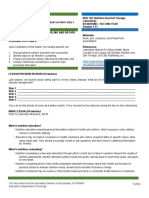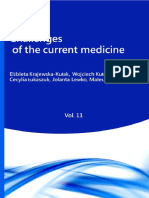Bioethics Session 11 SAS
Bioethics Session 11 SAS
Uploaded by
Marian BiaCopyright:
Available Formats
Bioethics Session 11 SAS
Bioethics Session 11 SAS
Uploaded by
Marian BiaCopyright
Available Formats
Share this document
Did you find this document useful?
Is this content inappropriate?
Copyright:
Available Formats
Bioethics Session 11 SAS
Bioethics Session 11 SAS
Uploaded by
Marian BiaCopyright:
Available Formats
Health Care Ethics
(Bioethics)
Module #11 Student Activity Sheet
Name: _________________________________________________________________ Class number: _______
Section: ____________ Schedule: ________________________________________ Date: ________________
Lesson Title: Role Fidelity Part 2 Materials:
Learning Targets: Pen, paper, index card, book, and class List
At the end of the module, students will be able to:
1. Explain the difference between a moral duty and a moral
option regarding a duty to treat; References:
2. List three basic principles that underpin our need to be
sensitive to cultural difference between ourselves and our Ethics of Health Care: A Guide for Clinical
patients.; and, Practice Fourth Edition, Raymond S. Edge, J.
3. Identify common functions of ethics committees Randall Groves
A. LESSON PREVIEW/REVIEW
Brain Teaser: Students will be asked to answer the following questions.
1. A process in which a patient or the patient’s family is introduced to additional health resources in the community in
which the referring practitioner has a financial interest.
Answer: _________________
2. This principle stands for many things including dedication, loyalty, truthfulness, advocacy and fairness to patients.
Nurses are encouraged to keep their commitments, based on their virtue of caring. They should always be in line with
their practice.
Answer: _________________
3. What code of conduct is represented when a healthcare practitioner joins together performing business venture?
Answer: _________________
4. TRUE OR FALSE: It is none of our business if we saw a colleague who always comes to work drunk especially in his or
her night shift duty because that is of personal matter. Why?
Answer: _________________
B. MAIN LESSON
Health Care Provision in a Multicultural Society
We are a nation of immigrants, a multicultural society, a universal nation, a pluralistic society
We have competing ideas regarding basic issues such as the meaning of health and illness
Most health care practitioners in the United States adhere to Western system of health care delivery
Health care providers often not only ethnocentric but also xenophobic
Culture shock: communication barrier raised; problem patient or uncommunicative one
ANA Committee on Ethics
Fundamental criteria for moral duty decisions:
Patient at significant risk of harm, loss, or damage if practitioner does not assist
Practitioner’s intervention or care directly relevant to preventing harm
Practitioner’s care will probably prevent harm, loss, or damage to patient
Benefit the patient will gain outweighs any harm practitioner might incur and does not present more than a minimal
risk to health care provider
If practitioner answers yes to all four criteria, it is a moral duty to treat under principle of beneficence
THIS DOCUMENT IS THE PROPERTY OF PHINMA EDUCATION 1
Health Care Ethics
(Bioethics)
Module #11 Student Activity Sheet
Name: _________________________________________________________________ Class number: _______
Section: ____________ Schedule: ________________________________________ Date: ________________
If all criteria could not be answered with yes, the decision to treat would become a moral option rather than a duty
for the practitioner
Institutional Ethics Committee
Interdisciplinary body of health care providers, community representatives, and nonmedical professionals
Address ethical questions within health care institution, especially on care of patients
Committees play advisory role
Often multidisciplinary group
Physicians, nurses, social workers, philosophers, laypersons, lawyers, administrators, religious leaders
Ethical training increasing in health care programs
CHECK FOR UNDERSTANDING
You will answer and rationalize this by yourself. This will be recorded as your quiz. One (1) point will be given to correct
answer and another one (1) point for the correct ratio. Superimpositions or erasures in you answer/ratio is not allowed.
1. An interdisciplinary body of health care providers, community representatives, and non-medical professionals who
address ethical questions within the health care institution.
A. American Nurses Association
B. Institutional Ethics Committee
C. Joint Commission
D. None of the above
Answer: ________
Rationale:________________________________________________________________________________________
_________________________________________________________________________________________________
_________________________________________________________________________________________________
2. An act or course of action that is required by one on the basis of moral position is termed.?
A. Role fidelity
B. Moral duty
C. Moral option
D. Morality
Answer: ________
Rationale:________________________________________________________________________________________
_________________________________________________________________________________________________
_________________________________________________________________________________________________
3. A high-stress situation in which one finds oneself in another culture in which former behavior patterns are ineffective
and one fails to understand the basic cues of social intercourse is termed .
A. Culture shock
B. Ethnocentrism
C. Culture bias
D. Racism
Answer: ________
Rationale:________________________________________________________________________________________
_________________________________________________________________________________________________
_________________________________________________________________________________________________
4. The patient with a heart condition who is restricted to be. Although he is told to remain in bed and appears to
understand, he is found several times a day standing and gazing out his window. The patient, a devout Muslim who by
faith is required to pray several times a day facing in a particular direction, feels that the religious priority overcomes the
requirement of bedrest. What should you do if you are assigned to this patient?
THIS DOCUMENT IS THE PROPERTY OF PHINMA EDUCATION 2
Health Care Ethics
(Bioethics)
Module #11 Student Activity Sheet
Name: _________________________________________________________________ Class number: _______
Section: ____________ Schedule: ________________________________________ Date: ________________
A. Report the patient for being uncooperative
B. Restraint the patient
C. Respect the patient’s cultural activity
D. None of the above
ANSWER: C
Answer: ________
Rationale:________________________________________________________________________________________
_________________________________________________________________________________________________
_________________________________________________________________________________________________
5. It is the most devastating Ebola outbreak dates back in?
A. December 2013
B. March 2014
C. August 2015
D. None of the above
Answer: ________
Rationale:________________________________________________________________________________________
_________________________________________________________________________________________________
_________________________________________________________________________________________________
C. LESSON WRAP-UP
AL Activity: Muddiest Point
In today’s session, what was least clear to you?
_________________________________________________________________________________________________
_________________________________________________________________________________________________
_________________________________________________________________________________________________
_________________________________________________________________________________________________
_________________________________________________________________________________________________
_________________________________________________________________________________________________
THIS DOCUMENT IS THE PROPERTY OF PHINMA EDUCATION 3
You might also like
- Bioethics Sas 5 (Olandres, Maricon Morales)No ratings yetBioethics Sas 5 (Olandres, Maricon Morales)5 pages
- Mark Jon Gloria Tamayo - GEN 006 - SAS#9 - 2324 - PRINCIPLES OF BIOETHICS (PART 2)No ratings yetMark Jon Gloria Tamayo - GEN 006 - SAS#9 - 2324 - PRINCIPLES OF BIOETHICS (PART 2)4 pages
- Bioethics Sas 4 (Olandres, Maricon Morales)No ratings yetBioethics Sas 4 (Olandres, Maricon Morales)6 pages
- Health 9 Activity 1 - My Healthy EnvironmentNo ratings yetHealth 9 Activity 1 - My Healthy Environment1 page
- Diocese of Imus Catholic Educational System, Inc. Office of The Superintendent of The Diocesan SchoolsNo ratings yetDiocese of Imus Catholic Educational System, Inc. Office of The Superintendent of The Diocesan Schools2 pages
- Diocese of Imus Catholic Educational System, Inc. Office of The Superintendent of The Diocesan SchoolsNo ratings yetDiocese of Imus Catholic Educational System, Inc. Office of The Superintendent of The Diocesan Schools2 pages
- Health10 - q1 - Las - wk2 - HEALTH INFORMATION, HEALTH SERVICES AND HEALTH CARE PLANSNo ratings yetHealth10 - q1 - Las - wk2 - HEALTH INFORMATION, HEALTH SERVICES AND HEALTH CARE PLANS4 pages
- Health10 q1 Mod2 Healthcare Providers and Fraudulent Services Ver2 Pages DeletedNo ratings yetHealth10 q1 Mod2 Healthcare Providers and Fraudulent Services Ver2 Pages Deleted20 pages
- Mapeh: Music - Arts - Physical Education - Health100% (1)Mapeh: Music - Arts - Physical Education - Health23 pages
- Quarter 1 Module No. 4 Topic: Consumer Health Lesson: QUACKERY100% (3)Quarter 1 Module No. 4 Topic: Consumer Health Lesson: QUACKERY8 pages
- School of Health and Allied Health Sciences Nursing DepartmentNo ratings yetSchool of Health and Allied Health Sciences Nursing Department2 pages
- 2ND Quarter Examinations in Pe & Health 1No ratings yet2ND Quarter Examinations in Pe & Health 13 pages
- Superseded: Committee On Herbal Medicinal Products (HMPC)No ratings yetSuperseded: Committee On Herbal Medicinal Products (HMPC)38 pages
- Material Safety Data Sheet Cobalt Phthalocyanine (Copc)No ratings yetMaterial Safety Data Sheet Cobalt Phthalocyanine (Copc)6 pages
- The 24 Romanian National Conference of Paediatric Haematology and OncologyNo ratings yetThe 24 Romanian National Conference of Paediatric Haematology and Oncology10 pages
- Evidence-Based Management of Patients With Colles' Fractures in Emergency Departments: A Case-Based Critical ReflectionNo ratings yetEvidence-Based Management of Patients With Colles' Fractures in Emergency Departments: A Case-Based Critical Reflection7 pages
- Personal Independence-Payment-FactsheetNo ratings yetPersonal Independence-Payment-Factsheet12 pages
- Iot Based Implementation of The Smart Health Care System & ManagementNo ratings yetIot Based Implementation of The Smart Health Care System & Management4 pages
- Challenges of The Current Medicine Vol. 11No ratings yetChallenges of The Current Medicine Vol. 11607 pages
- Medical Ethics and Professional Practice Yr III and IV - Lecture IIINo ratings yetMedical Ethics and Professional Practice Yr III and IV - Lecture III11 pages
- Human Resources For Health: Identifying Factors For Job Motivation of Rural Health Workers in North Viet NamNo ratings yetHuman Resources For Health: Identifying Factors For Job Motivation of Rural Health Workers in North Viet Nam11 pages
- An Overview Storage of Pharmaceutical Products PDFNo ratings yetAn Overview Storage of Pharmaceutical Products PDF18 pages
- Certificate For COVID-19 Vaccination: Beneficiary DetailsNo ratings yetCertificate For COVID-19 Vaccination: Beneficiary Details1 page
- Validity of The Functional Loewenstein Occupational Therapy Cognitive Assessment (FLOTCA)No ratings yetValidity of The Functional Loewenstein Occupational Therapy Cognitive Assessment (FLOTCA)7 pages
- 来华人员保险信息清单 List of insurance information for foreigner staying in ChinaNo ratings yet来华人员保险信息清单 List of insurance information for foreigner staying in China1 page
- New England Journal of Medicine Ranking 37th - Measuring The Performance of The U.S. Health Care SystemNo ratings yetNew England Journal of Medicine Ranking 37th - Measuring The Performance of The U.S. Health Care System2 pages

























































































